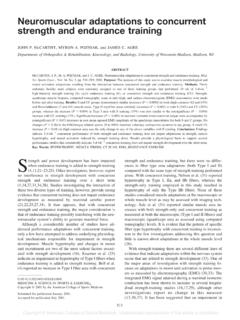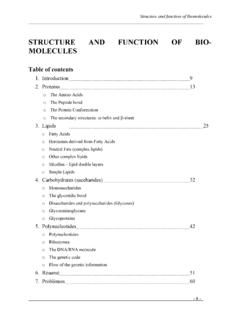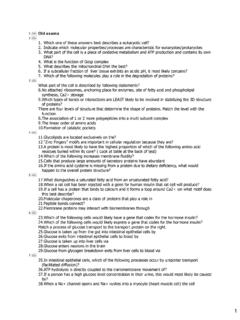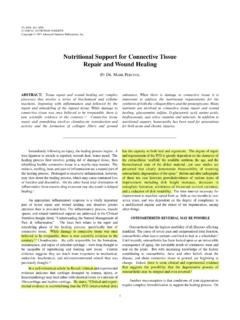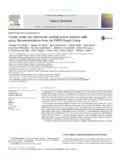Transcription of Kevin D. Tipton, Arny A. Ferrando, Stuart M. Phillips ...
1 276:628-634, 1999. Am J Physiol Endocrinol MetabR. Wolfe Kevin D. tipton , Arny A. Ferrando, Stuart M. Phillips , David Doyle, Jr. and Robert You might find this additional information articles, 21 of which you can access free at: This article cites #BIBL45 other HighWire hosted articles, the first 5 are: This article has been cited by [PDF] [Full Text] [Abstract], April 1, 2009; 106 (4): 1394-1402. J Appl PhysiolK. R. Howarth, N. A. Moreau, S. M. Phillips and M. J. Gibala stimulates skeletal muscle protein synthesis in humansCoingestion of protein with carbohydrate during recovery from endurance exercise [PDF] [Full Text] [Abstract], May 1, 2009; 106 (5): 1692-1701. J Appl PhysiolN.
2 A. Burd, J. E. Tang, D. R. Moore and S. M. Phillips sex-based differencesExercise training and protein metabolism: influences of contraction, protein intake, and [PDF] [Full Text] [Abstract], May 1, 2009; 106 (5): 1730-1739. J Appl PhysiolS. Fujita, H. C. Dreyer, M. J. Drummond, E. L. Glynn, E. Volpi and B. B. Rasmussen postexercise muscle protein synthesisEssential amino acid and carbohydrate ingestion before resistance exercise does not enhance [PDF] [Full Text] [Abstract], June 1, 2009; 106 (6): 2026-2039. J Appl PhysiolV. Kumar, P. Atherton, K. Smith and M. J. Rennie Human muscle protein synthesis and breakdown during and after exercise [PDF] [Full Text] [Abstract], June 1, 2009; 106 (6): 2040-2048.
3 J Appl PhysiolR. Koopman and L. J. C. van Loon Aging, exercise, and muscle protein metabolismon the following topics: be found at Medline items on this article's topics Physiology .. Humans Medicine .. Exercise Medicine .. Fitness (Physical Activity) Physiology .. Exertion Biochemistry .. Muscle Proteins Oncology .. Protein synthesis including high-resolution figures, can be found at: Updated information and services can be found at: AJP - Endocrinology and Metabolismabout Additional material and information information is current as of June 8, 2009 . Copyright 2005 by the American Physiological Society. ISSN: 0193-1849, ESSN: 1522-1555. Visit our website at organization.
4 It is published 12 times a year (monthly) by the American Physiological Society, 9650 Rockville Pike, Bethesda MD publishes results of original studies about endocrine and metabolic systems on any level ofAJP - Endocrinology and Metabolism on June 8, 2009 from Postexercise net protein synthesis in human musclefrom orally administered amino acidsKEVIN D. tipton , ARNY A. FERRANDO, Stuart M. Phillips ,DAVID DOYLE, JR., AND ROBERT R. WOLFEM etabolism Unit, Shriners Burns Institute, and Departments of Surgery and Anesthesiology,University of Texas Medical Branch, Galveston, Texas 77550 tipton , Kevin D., Arny A. Ferrando, Stuart M. Phill-ips, David Doyle, Jr., and Robert R. protein synthesis in human muscle from orally adminis-tered amino J.
5 (Endocrinol. ): E628 E634, 1999. We examined the response of netmuscle protein synthesis to ingestion of amino acids after about of resistance exercise. A primed, constant infusion ofL-[ring-2H5]phenylalanine was used to measure net muscleprotein balance in three male and three female volunteers onthree occasions. Subjects consumed in random order 1 liter of1) a mixed amino acid (40 g) solution (MAA),2) an essentialamino acid (40 g) solution (EAA), and3) a placebo solution(PLA). Arterial amino acid concentrations increased,150 640% above baseline during ingestion of MAA and EAA. Netmuscle protein balance was significantly increased fromnegative during PLA ingestion (250623 nmol min21 100ml leg volume21) to positive during MAA ingestion (17613nmol min21 100 ml leg volume21) and EAA (29614nmol min21 100 ml leg volume21;P, ).
6 Because netbalance was similar for MAA and EAA, it does not appearnecessary to include nonessential amino acids in a formula-tion designed to elicit an anabolic response from muscle afterexercise. We concluded that ingestion of oral essential aminoacids results in a change from net muscle protein degradationto net muscle protein synthesis after heavy resistance exer-cise in humans similar to that seen when the amino acidswere protein synthesis ; muscle protein breakdown; resis-tance exercise; stable isotopesEXERCISEhas a profound effect on muscle protein me-tabolism. Both muscle protein synthesis (7, 10, 12, 21,26, 29) and muscle protein breakdown (7, 21) areincreased after exercise.
7 Postexercise nutrition hasbeen extensively examined with respect to carbohy-drates and lipids, but less is known concerning proteinmetabolism. Previously, our laboratory (8) found thathyperaminoacidemia resulting from intravenous infu-sion of amino acids increased protein synthesis at , the infusion of amino acids after exerciseincreased muscle protein synthesis more than at rest,and the normal increase in muscle protein breakdownwas prevented, thereby resulting in net protein synthe-sis (8). Thus provision of amino acids after exercise hasan anabolic effect on , as well as recreational exercisers and thoseusing exercise for rehabilitation, might benefit fromincreasing muscle anabolism after exercise.
8 However,infusion of amino acids is not a practical method ofamino acid delivery for exercising humans. Oral solu-tions would be much more practical as a mode fordelivery of supplements designed to stimulate muscleprotein anabolism in exercising humans. It is not clearwhether the hyperaminoacidemia from orally adminis-tered amino acids is similar to and has the same effectas that from infusion of amino acids. First-pass splanch-nic uptake accounts for 20 90% of amino acids (13, 17,18). Furthermore, because exercise increases splanch-nic protein breakdown (27), it is possible that splanch-nic extraction after exercise would be even greater thannormal, thereby further affecting the availability ofamino acids from oral solutions.
9 However, the responseof muscle protein metabolism to oral amino acid inges-tion after exercise has never been examined. Thepresent study was performed to test the hypothesisthat an orally administered solution of amino acidswould increase net protein synthesis after heavy resis-tance exercise in untrained results in increased production of alanineand other nonessential amino acids (9, 14). Thus theavailability of nonessential amino N is not greatlydiminished by exercise. We therefore hypothesizedthat, after exercise, it is unnecessary to include nones-sential amino acids in a supplement designed to in-crease muscle protein anabolism. Therefore, a second-ary purpose of our study was to determine whether asolution composed of only essential amino acids (EAA)would be equally capable of increasing postexercisemuscle anabolism as would a mixed amino acid solu-tion (MAA).
10 METHODSS ubjectsSix healthy adults (three men and three women) volun-teered to serve as subjects for the study. The study design,purpose, and possible risks were explained to each subjectbefore written consent was obtained. The study protocol wasapproved by the Institutional Review Board and the GeneralClinical Research Center (GCRC) of the University of TexasMedical Branch at Galveston. Subjects had not participatedin a resistance exercise training program yr beforeparticipating in the study and were instructed not to changetheir activity patterns for the duration of the study. Legvolume was estimated with an anthropometric approach. Themean age was 2262 (SE) yr, height was 17065 cm, weightwas 6663 kg, body mass index was 2361 kg/m2, and legvolume was 8,6316652 ml.
